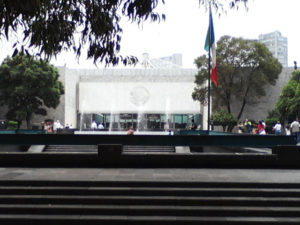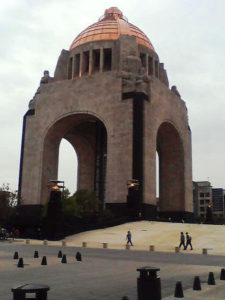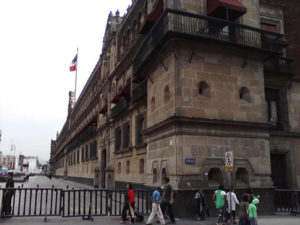What can one say about Mexico City? It’s the capital of Mexico, the biggest metropolis in the Western Hemisphere and the world’s eighth-richest city. It’s also a first-rate tourist attraction.
Located in the Valle de México (Valley of Mexico), a natural bowl ringed in by volcanoes and mountains, the city sits at an altitude of 7,350 feet above sea level. That makes it higher than Denver, Colorado, which at 5,280 feet is the Mile-High City.
When my family and I visited Mexico City this past summer, the climate was quite pleasant, much cooler than my home in the United States when we returned.
In the Spanish language, Mexico City is called La Ciudad de México or, more commonly, simply México. Like Washington, D.C., Mexico City is also a federal district, not the part of any state. Thus it’s also called El De Efe, Spanish for D.F., the Distrito Federal.
Interestingly, the city was not named after the country of Mexico. Instead, the country of Mexico was named after the city. That’s fitting, given the enormous impact it has on the entire nation.
Mexico’s Federal District covers 573 square miles, and has between 8 and 9 million inhabitants. However, Mexico City proper and adjacent urban areas of the states of Mexico and Hidalgo form a much larger metropolitan area. Approaching Mexico City from the north, you enter the built-up areas long before arriving at the official border of the Federal District.
Population-wise, the entire metropolitan area has about 21.4 million inhabitants, making it the Western Hemisphere’s biggest. Granted, some sources will list Brazil’s Sao Paulo as the biggest. Such enumerations depend greatly upon which areas are included in defining the metropolitan area in question.
Mexico City dominates the entire nation of Mexico. It’s not just that it’s the political capital of a centralized republic, though even that would be enough. But Mexico City dominates the entire country economically, culturally and artistically. More products are manufactured there than anywhere in the country. More books are printed there. The major newspapers and television networks are located there, so if you watch national Mexican news, even out in the provinces, it’s still oriented toward Mexico City.
The cultural offerings are enormous. Mexico City is said to have more museums (around 160) than any other city in the world, 100 art galleries and 30 concert halls.
What’s amazing from a touristic point of view is how accessible the city is. Although it is a vast and populated metropolis, the sights most tourists are interested in seeing are quite accessible, and located in recognizable clusters.
Chief among these is the Centro Histórico, the Historic City Center, downtown Mexico City. There you can visit the Zocalo, the city’s main plaza, with the National Palace, the Cathedral and the Templo Mayor Aztec archaeological museum.
Within walking distance are the Palacio de Bellas Artes building, the Torre Latinoamericana skyscraper and the Alameda park. And there is much more. Just strolling the streets of downtown Mexico City, there is so much to see with the vintage buildings, bustling commerce and vibrant street life.
Another group of attractions is clustered at Chapultepec Park. There you can climb Chapultepec, which is Aztec for “Grasshopper Hill,” and visit the Castle on top of it. You can visit the world-famous Anthropological Museum, the zoo, or just stroll in the woods.
There are several modes of transport. My preferred transport is the Metro, the subway system. The various routes crisscross each other, forming a vast grid below the city. When you buy a ticket to the Metro, you don’t have to pay again until you exit the system. It took us just about everywhere we needed to go, when we weren’t walking.
The visitor to Mexico City is never far from its fascinating history. It was founded by the Aztecs in 1325 on a small island on Lake Texcoco. (Centuries of urbanization have obliterated most of the lake). As capital of the Aztec Empire, the city was known as Tenochtitlan.
In 1519, Hernan Cortes and the Spaniards arrived and, by 1521, the Spaniards and their Indian allies had defeated the Aztecs. The city of Tenochtitlan was destroyed, but the same stones were used to construct a new Spanish city.
For three centuries, from 1521 to 1821 (how convenient for students!), the city of Mexico was capital of the enormous colony of Nueva España (New Spain).
In 1821, Mexico City became the capital of the newly-independent nation of Mexico, as New Spain was renamed, after the city. For the past two centuries, Mexico City has been at the heart of the vicissitudes of Mexican history. It has passed through political unrest, civil wars, occupations by the U.S. military and later the French, and the bloody conflict known officially as the Mexican Revolution.
Through the centuries, nevertheless, one thing that remained constant was that the city was a capital city. Whether it was ruled by an Aztec emperor, a Spanish viceroy or a president of Mexico, it was still a capital city.
Seen historically, the various tourist attractions in the city represent various eras of Mexican history. The Aztec era is represented by the ruins of the Templo Mayor (with its on-site museum). The Spanish colonial era is represented by the National Cathedral and Tolsa’s equestrian statue of King Carlos IV, the world’s second largest cast bronze statue.
The National Palace represents both the Spanish Colonial Era (in its design) and the Independent Mexico era (in its many historical associations with and present use by the Mexican federal government).
Chapultepec is related to various historical eras — that of the Aztecs, the Colonial period and the battle with the U.S. Army fought there. Also, the Castle (now a museum) was a residence of both the emperor Maximilian in the 1860s and of President Porfirio Diaz in the late 1800s and early 1900s.
Mexican nationalism is celebrated in various structures, such as the Monument to the Revolution and the Ángel de la Independencia.
The more recent history of Mexico is exemplified by such structures as the Torre Latinoamericana skyscraper, the Estadio Azteca stadium and the Bolsa Mexicana de Valores (the Stock Exchange).
And the list goes on and on….
This past summer, my wife and I took our two sons on a visit to Mexico City. It was the first visit there for the both of them, and the boys enjoyed it. We spent one week there, and we did a lot of sightseeing every single day.
A week is sufficient to see the most famous sights. We were able to accomplish that. However, a week is certainly not sufficient to visit everything of interest in Mexico City. There is so much more to see and experience. Even the city’s permanent residents have a hard time getting around to all of it!




















